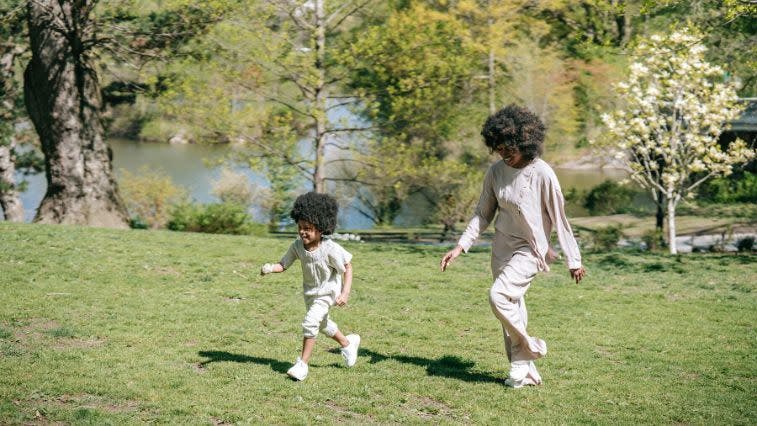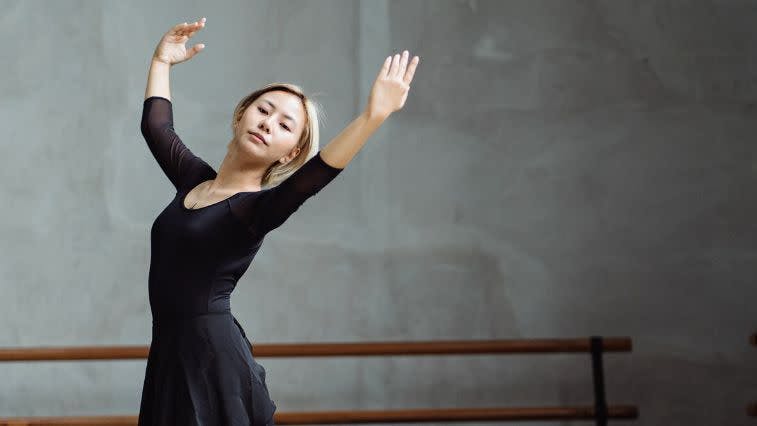The Shame-Free Guide for How to Start Working Out Without Wanting to Stop
Our content strives to support, inform, and motivate you to meet your health goals. We want to be your trusted source of expert- and science-backed info dispensed in simple, actionable ways. Read our Editorial Guidelines.
Ever wonder what it would be like to be a kid again? Running without intentionally doing it for exercise. Jumping around without knowing it was getting your heart rate up and benefiting your health in so many ways. Kids are free souls, ready to run and play once their bodies figure out how to move on their own two feet. Ever seen a baby trying to stumble away from their parents with those wobbly legs? They just want to move and have fun!
Babies, toddlers, and kids are in tune with our innate need to move often. Especially when we’re young, physical activity is, of course, functional but it’s also centered around fun-seeking adventure and exploration. Kids build forts, chase each other, ride bikes and skateboards, swim and splash, bounce on trampolines, and dig in the dirt for the joy it brings.
Now, let’s be real for a moment… we’re all aware that kids don’t have worries or stresses that consume their minds like adults do. They don’t pay bills and don’t have their own families to take care of. But, that doesn’t mean adult responsibilities should prevent us from joyful movement.
Physical activity has been proven in multiple studies to enhance emotional resilience in adults. One study showed that even one bout of exercise showed a positive impact on coping with stress, but regular exercisers benefit from enhanced emotional resilience.
I’m a certified personal trainer and I know first-hand that you can reduce stress and increase emotional stability by having fun like you once did as a kid. We hear the phrase all the time “channel your inner child.” Talk about motivation to get moving again!
How Do We Make Movement Consistent and Fun Again?

What if you viewed exercise the same way you did as a kid? Find something you enjoy and turn it into a natural routine that will improve your day-to-day tasks as well as your health. The two key words in that last phrase are “natural” and “enjoy,” which go hand in hand. When it comes to routines, “natural” simply means to have a customary or regular course of action. Enjoyment is action by possessing and benefiting from something. What becomes natural enjoyment becomes a habit; what becomes a habit becomes a lifestyle.
What type of movement was or is natural enjoyment to you?
Here’s an inspiration list to ignite a spark:
Join a dance class
Join a local hiking club
Gamify movement with Ring Fit on Nintendo Switch
Ride a bike with your family
Swim at your local community pool
Check out recreational sports in your area
Play with your kids outside
Shoot some hoops
Find a local walking path and bring a friend
Use This Inspirational Story to Inspire Motivation
When I meet with a client for the first time, I listen to their goals and desires. From there, I mold a specific plan based on what they want. The client is the expert in their own lives and my role is to help facilitate a successful routine within their lifestyle.
Linnette was a client of mine and she had a strong desire to “get in shape” and feel more energized. She is a mother of three kids who all have after-school activities. She also has a standard day job that starts at 9 am and goes until 5 pm. When I first met with Linnette, we discussed her goals, set milestones to hit, and created a weekly workout regimen for her to follow.
She was adamant about having a strict routine in place that she could follow to a T. We included resistance training on specific days of the week and cardio training on specific days. Society told Linnette that joining a gym and doing sets and reps while walking on a treadmill was the way to get into shape. I respected her decision and provided her with a plan to do just that. Again, she’s the expert in her own life.
Linnette was off to the races with her new routine, and started the Monday after we met. One month went by and Linnette only got eight of her 20 scheduled workouts completed. It was time to reassess and reflect on her first month and see what challenges were coming up for her. As her trainer, I really wanted her to see the success she deserves.
I used a lot of reflective questions during our chat, such as: “Why do you feel you couldn’t get all of your workouts in throughout the week?”
Her answer: “I didn’t feel like I had the time throughout the week, and there were a lot of days where I felt tired.”
“Were the workouts enjoyable for you while you were doing them?”
Her answer: “I did feel good after doing them but it took a lot to want to start the workouts.”
“Where were your motivational levels during the entire month?”
Her answer: “I didn’t feel too motivated throughout the week because I was worried about other things I had to get done.”
After we had this back-and-forth discussion, this allowed me the opportunity to ask the question that turned everything around.
“If you can think of any movement (past or present) that brought enjoyment to your life, what would that be?”
Her answer: “I used to love dancing! I did that as a kid and even did it in high school. My daughter actually dances right now for her school.”

From there, we found a local dance studio that she joined and took classes two days per week. We then included music-based resistance training routines and used light dancing as active rest. She also found herself dancing with her kids at home and even doing some online dance classes with them. To this day, Linnette hasn’t missed a workout after that first month!
Dancing was her natural enjoyment, which turned into a habit, which turned into a lifestyle, which helped her achieve the goals she had when we met for the first time. All I did was put her enjoyment into a structured routine. Linnette did the rest and never looked back.
How to Reframe Reasons for Not Working Out
Linnette overcame all of the barriers and snags that people experience with exercise routines to rediscover her love of dance and get moving again.
The following examples illustrate two of the most common fears that can derail workout motivation plus strategies for overcoming them.
“I haven’t worked out since I was a kid. My body has gotten old and I can’t do those things anymore.”
Yes, you can.
There’s a term called progressive overload, which allows the body to adapt. Untrained individuals (someone who hasn’t performed physical activity for a month or longer) can follow a beginner routine and gradually increase their sets, reps, and workouts according to how their body adapts. Our bodies are very resilient and have amazing ways of increasing the ability to move.
Keep in mind that everyone has their own process for this based on environmental factors, age, stage of life, recent injuries, etc. Certified personal trainers can help you with your progressive overload progress.
“I have a busy schedule and I can’t find the time to get movement in.”
The answer to this barrier has been partially answered above. Find activities that bring you natural enjoyment. They’ll find their way into your daily routine because we seamlessly prioritize what we like.
Everybody has “time”... it’s more a matter of how you prioritize your time. We all have different ways of organizing our schedules and can use methods like habit stacking or phase-of-the-day routines to make sure we fit in the most important stuff.
Habit stacking means you tack a new habit onto something you already do. While you wait for your morning coffee to brew, hold a 60-second plank, then hold a 30-second side plank on the left, then 30 seconds on the right. Pop up and your coffee should be ready.
Phase-of-the-day routines refers to things you tend to do at different times of day. These natural transition times can provide moments for short bouts of physical activity. If you work in an office and take a lunch break, set aside 10 minutes to walk outside (in fact, do this if you work from home, too). Either in the morning when you wake up or as part of your bedtime routine, try a gentle vinyasa yoga flow to relax and calm your mind.
An Easy 6-Step Plan to Start Working Out
Let’s conclude with actionable steps to jumpstart your exercise journey.
Step 1: Nail down fitness goals and what you want to accomplish. Be specific by making one or two SMART goals. From there, break those down into milestones to keep you motivated.
Step 2: Think about activities you did as a kid that you found enjoyable and make a list.
Step 3: Look for opportunities to do your list of activities you wrote down from step 2. (Use the inspiration list from above or find a trainer to help you with this.)
Step 4: Plot a weekly routine with time slots available to get a workout in. Set specific days and times to hit such as Mon., Wed., Fri. at 5:00 (am or pm) for 30 minutes. Remember, everyone has their own starting point.
Step 5: Plug in the activities you listed into the weekly routine you laid out from step 4 into calendars on your phone and at work. Let’s normalize taking time to exercise on our work calendars.
Step 6: Start the routine and see all of your goals come true!